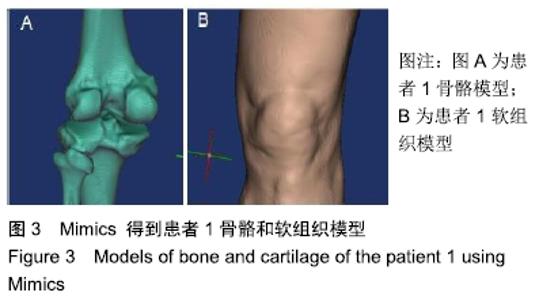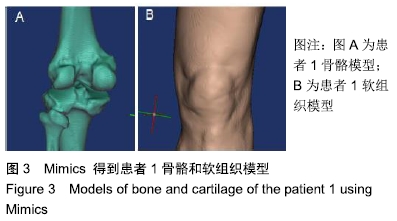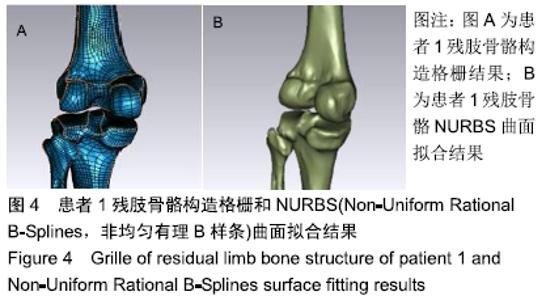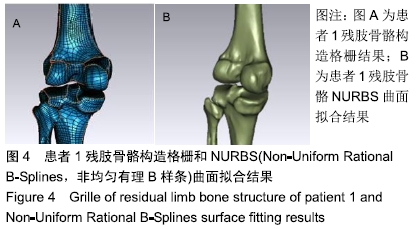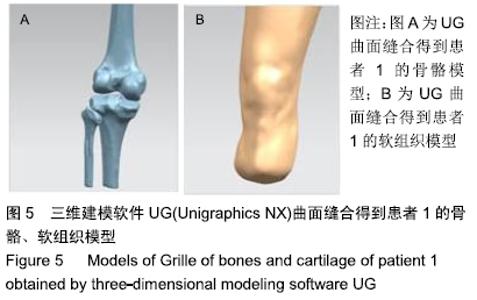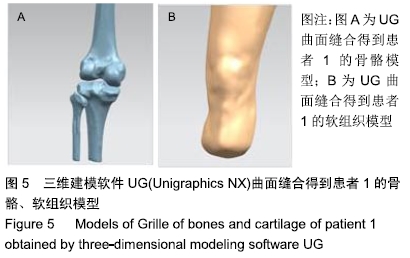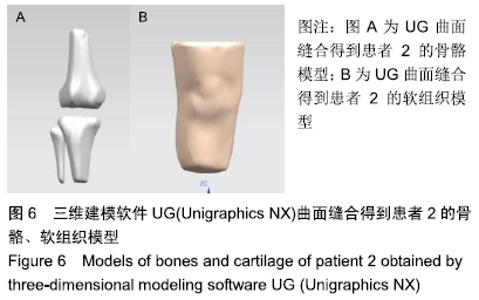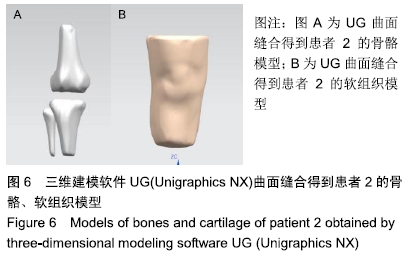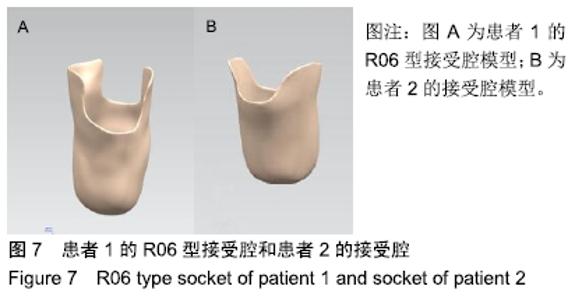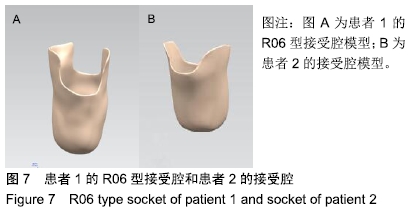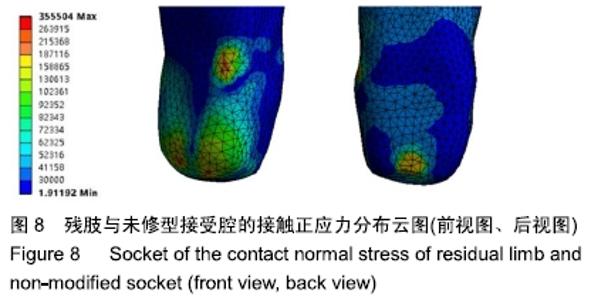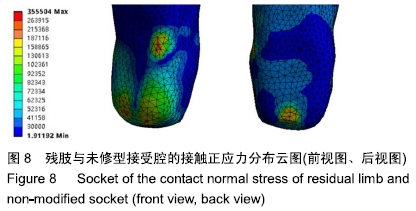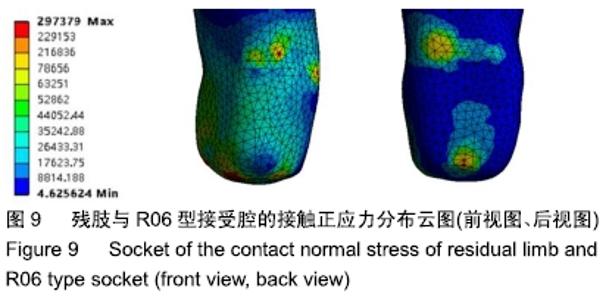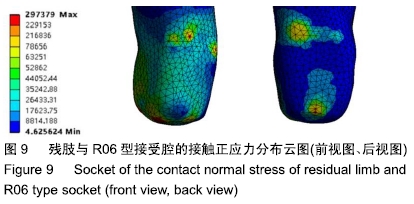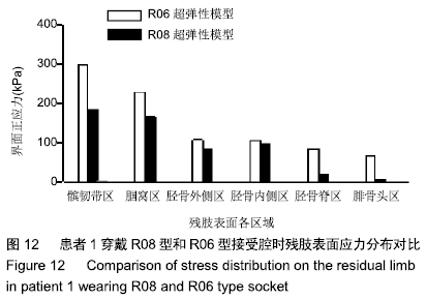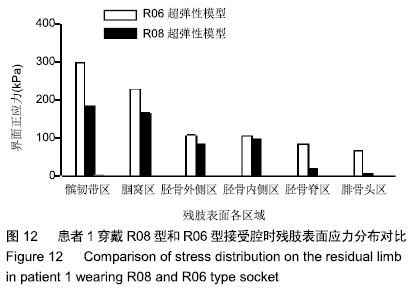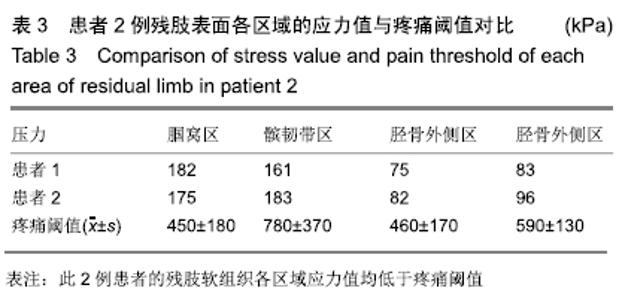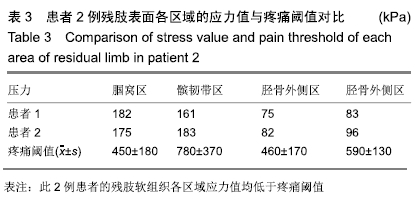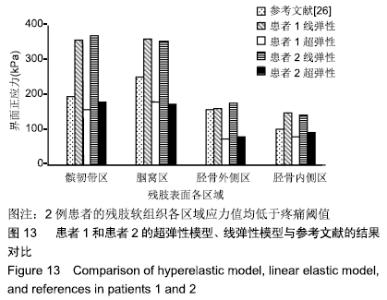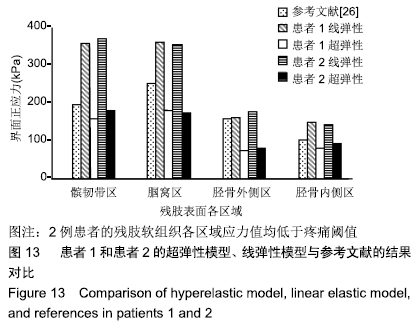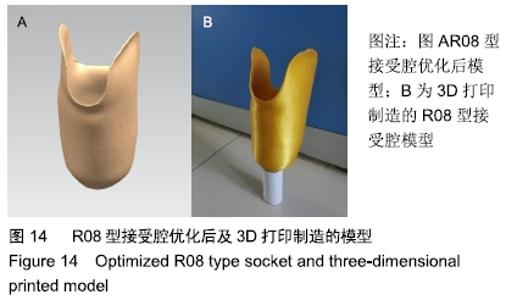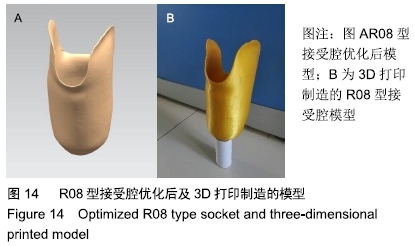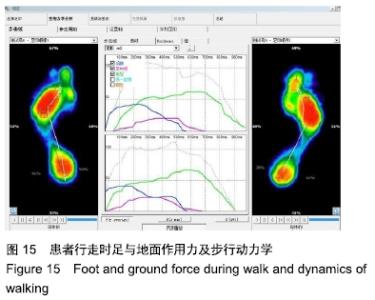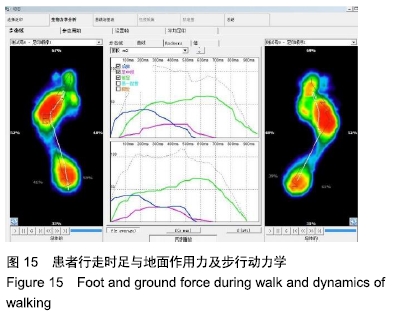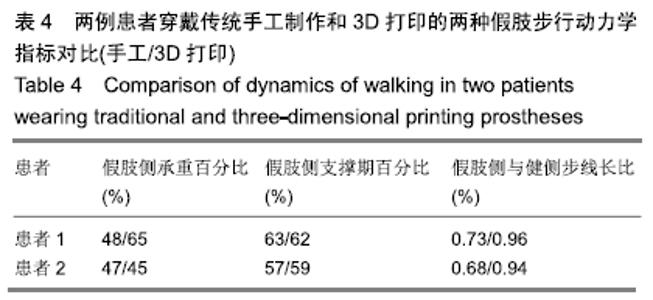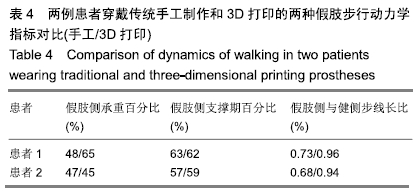Chinese Journal of Tissue Engineering Research ›› 2020, Vol. 24 ›› Issue (6): 862-868.doi: 10.3969/j.issn.2095-4344.2442
Previous Articles Next Articles
Design of the prosthetic socket and the finite element analysis of the interfacial stress
Wang Xiaohui1, Wang Kun1, Hu Zhiyong1, Tian Hongliang2
- 1School of Mechanical Engineering, Inner Mongolia University of Technology, Hohhot 010000, Inner Mongolia Autonomous Region, China; 2Inner Mongolia Honorary Military Rehabilitation Center, Hohhot 010000, Inner Mongolia Autonomous Region, China
-
Received:2019-05-31Revised:2019-06-04Accepted:2019-07-27Online:2020-02-28Published:2020-01-17 -
Contact:Wang Kun, Master, Associate Professor, School of Mechanical Engineering, Inner Mongolia University of Technology, Hohhot 010000, Inner Mongolia Autonomous Region, China -
About author:Wang Xiaohui, Master, School of Mechanical Engineering, Inner Mongolia University of Technology, Hohhot 010000, Inner Mongolia Autonomous Region, China -
Supported by:the Science and Technology Research Project of Inner Mongolia Autonomous Region High Education, No. NJZY18080; the Standard Project Ministry of Civil Affairs Industry, No. MZ2017-T-046; the Science and Technology Innovation Guidance Project of Inner Mongolia Autonomous Region
CLC Number:
Cite this article
Wang Xiaohui, Wang Kun, Hu Zhiyong, Tian Hongliang. Design of the prosthetic socket and the finite element analysis of the interfacial stress[J]. Chinese Journal of Tissue Engineering Research, 2020, 24(6): 862-868.
share this article
Add to citation manager EndNote|Reference Manager|ProCite|BibTeX|RefWorks
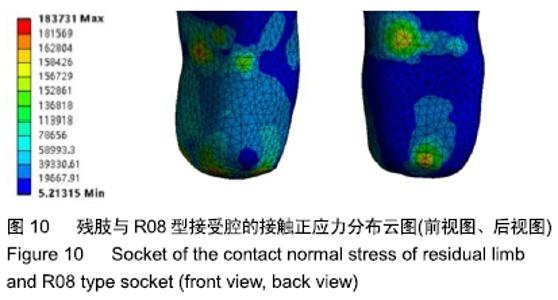
由应力分布云图可以看出,接受腔修型后,残肢底端前缘和胫骨脊区域的应力集中现象大幅减缓,髌韧带、腘窝和胫骨内外侧应力分别达到297,226,106及108 kPa。胫骨内外侧受力分布相对于未经修型的接受腔更加均匀合理,但是应力值较高。后侧腘窝处应力值相对于未经修型的接受腔大幅上升,但由于R06型接受腔的腘窝处修型量过大导致此处应力过高。 2.3.3 根据有限元结果反馈指导设计得到R08型接受腔 经修型后的R06模型接受腔,受力分布相对于未经修型接受腔有明显改善,但是部分区域仍需进一步修型。由应力分布结果可知,胫骨脊、腓骨头、腘窝处区域需要压力释放,且释放幅度应较大。胫骨内外侧需进行小幅度的压力释放,据此修型得到R08型接受腔。 2.3.4 患者1穿戴R08型接受腔残肢表面应力有限元分析将进一步修型得到的R08型接受腔与残肢的界面应力进行有限元分析,结果如图10所示。 "
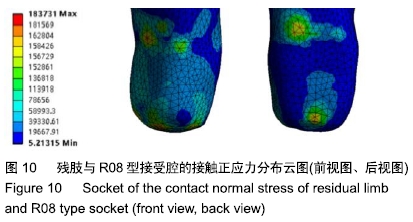
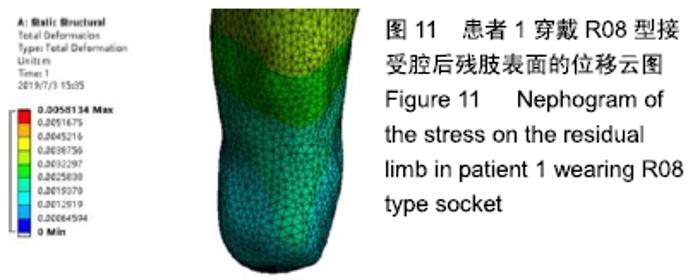
由图10可以看出,残肢表面应力主要分布在髌韧带、胫骨内外侧、腘窝等适合承重的区域,应力峰值分别为183,82,96及175 kPa。其中髌韧带(PT)处的应力最大。胫骨脊和腓骨头处的压力敏感区应力非常小。胫骨内外侧的软组织层较厚,可以承受一定程度的压力。 2.3.5 患者1穿戴R08型接受腔后残肢表面的位移 当患者承受体质量时,截断的骨头被推向接受腔。下面的软组织被压缩,较远处的软组织被向上推向膝盖。残肢穿戴R08型接受腔后表面的位移如图11所示。软组织相对接受腔的滑动在膝关节附近达到峰值5.8 mm。不同残肢的肌肉紧实程度决定滑移量大小,残肢肌肉越紧实滑移量越小,一般5-10 mm属于正常范围。故滑移量峰值5.8 mm符合实际接受腔穿戴情况。 "
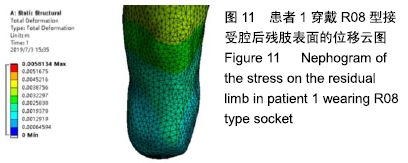
| [1] WANG M, LI R, JING J. Establishment and application of lower limb finite element model based on muscle groups. J Mech Med Biol.2018;18(8):1840024. [2] 李亚楠,钱秀清,孙翠莲,等.大腿假肢支撑期有限元分析[J].北京生物医学工程,2018,37(2):116-121. [3] LORENZELLI L, SORDO G, BAGOLINI A, et al. Socketmaster: Integrated Sensors System for the Optimised Design of Prosthetic Socket for above Knee Amputees//Cas. 2017. [4] PATERNÒ L, IBRAHIMI M, GRUPPIONI E, et al. Sockets for limb prostheses: a review of existing technologies and open challenges. IEEE Trans Biomed Eng. 2018;65(9):1996-2010. [5] HENRIKSON K, WEATHERSBY E, LARSEN B, et al. An inductive sensing system to measure in-socket residual limb displacements for people using lower-limb prostheses.Sensors.2018;18(11): 3840. [6] 王振泽,徐智,晏菲,等.下肢假肢接受腔对残肢肌肉萎缩影响的数值研究[J].生物医学工程学杂志,2018,35(6):887-891. [7] LEE W, ZHANG M, JIA X, et al. Finite element modeling of the contact interface between trans-tibial residual limb and prosthetic socket. Med Eng Phys. 2004;26(8):655-662. [8] ZHANG M, LORD M, TURNER-SMITH AR, et al. Development of a non-linear finite element modelling of the below-knee prosthetic socket interface. Med Eng Phys. 1995;17(8): 559-566. [9] ZACHARIAH SG, SANDERS JE. Finite element estimates of interface stress in the trans-tibial prosthesis using gap elements are different from those using automated contact. J Biomech. 2000;33(7):895-899. [10] GOH JCH, LEE PVS, TOH SL, et al. Development of an integrated CAD–FEA process for below-knee prosthetic sockets. Clin Biomech. 2005;20(6):623-629. [11] PENG HK, HSU LH, HUANG GF, et al. The Analysis and Measurement of Interface Pressures between Stump and Rapid Prototyping Prosthetic Socket Coated With a Resin Layer for Transtibial Amputee//13th International Conference on Biomedical Engineering. Springer, Berlin, Heidelberg. 2009:1720-1723. [12] NGUYEN KT, BENABOU L, ALFAYAD S. Systematic Review of Prosthetic Socket Fabrication using 3D printing//Proceedings of the 2018 4th International Conference on Mechatronics and Robotics Engineering. ACM. 2018:137-141. [13] 徐盼飞.基于Fusion 360协同功能应用的现代家具设计研究[D].成都:西南交通大学,2018. [14] 张绍岚,李古强,邵长庆.小腿假肢接受腔计算机三维模型的构建[J].中国组织工程研究与临床康复,2010,14(48):8954-8957. [15] 樊瑜波,蒲放,张明,等.个体化下肢小腿假肢接受腔设计的生物力学评价技术研究[J].中国生物医学工程学报, 2004,23(6):544-548. [16] 许华丽.基于TRIZ理论的人体假肢优化设计研究[D].杭州:浙江理工大学,2016. [17] 张明,樊瑜波.小腿假肢接受腔的三维有限元分析[J].生物医学工程学杂志, 2000,17(4):403-406. [18] ZHANG M, ROBERTS C. Comparison of computational analysis with clinical measurement of stresses on below-knee residual limb in a prosthetic socket. Med Eng Phys. 2000;22(9):607-612. [19] ZHANG M, MAK AFT, ROBERTS VC. Finite element modelling of a residual lower-limb in a prosthetic socket: a survey of the development in the first decade. Med Eng Phys.1998;20(5): 360-373. [20] DICKINSON AS, STEER JW, WORSLEY PR. Finite element analysis of the amputated lower limb: a systematic review and recommendations. Med Eng Phys. 2017;43:1. [21] PETRON A, DUVAL JF, HERR H. Multi-Indenter Device for in Vivo Biomechanical Tissue Measurement. IEEE Transactions on Neural Systems and Rehabilitation Engineering, 2017. [22] 孔亮,贾振岗,石磊,等.小腿残肢与接受腔界面的摩擦行为分析及测试[J].摩擦学学报,2014(6):650-657. [23] 穆晨,钱秀清,闫松华,等.预应力下大腿残肢站立中期时相的有限元分析[J].医用生物力学,2011,26(4):321-324. [24] 张明,麦福达,樊瑜波.小腿假肢接受腔的三维有限元分析[J].生物医学工程学杂志,2000,17(4):403-406. [25] ZHANG M, LEE WCC. Quantifying the regional load-bearing ability of trans-tibial stumps. Prosthet Orthot Int. 2006;30(1): 25-34. [26] 贾晓红,张明,王人成,等.小腿截肢患者残端应力的三维有限元动态分析[J].中国康复医学杂志,2004,19(5):334-336. [27] 贾晓红,张明,王人成,等.惯性载荷对截肢患者残肢/接受腔界面应力的影响研究[J].生物医学工程学杂志,2005,22(3):468-471. [28] TUAN LV, OHNISHI K, OTSUKA H, et al. Finite element analysis for the estimation of the ground reaction force and pressure beneath the foot prosthesis during the gait of transfemoral patients//Journal of Biomimetics, Biomaterials and Biomedical Engineering. Trans Tech Publications. 2017;33:1-11. [29] LUENGAS-CONTRERAS LA, CAMARGO-CASALLAS E, GUARDIOLA D. Modeling and simulation of prosthetic gait using a 3-d model of transtibial prosthesis. Revista Ciencias de la Salud. 2018;16(1): 82-100. [30] JAIMES ES, BOTÍA GCP, RODRIGUES PH, et al. Comparison of a transtibial socket design obtained by additive manufacturing and reverse engineering and a traditional model//Journal of Physics: Conference Series. IOP Publishing. 2018;1126(1):012016. [31] HAND B. Reinforced fill-compositing prosthetic apparatus and method of manufacturing: U.S. Patent Application 15/905,523[P]. 2018-8-30. |
| [1] | Xu Feng, Kang Hui, Wei Tanjun, Xi Jintao. Biomechanical analysis of different fixation methods of pedicle screws for thoracolumbar fracture [J]. Chinese Journal of Tissue Engineering Research, 2021, 25(9): 1313-1317. |
| [2] | Xiao Guoqing, Liu Xuanze, Yan Yuhao, Zhong Xihong. Influencing factors of knee flexion limitation after total knee arthroplasty with posterior stabilized prostheses [J]. Chinese Journal of Tissue Engineering Research, 2021, 25(9): 1362-1367. |
| [3] | Zhang Chong, Liu Zhiang, Yao Shuaihui, Gao Junsheng, Jiang Yan, Zhang Lu. Safety and effectiveness of topical application of tranexamic acid to reduce drainage of elderly femoral neck fractures after total hip arthroplasty [J]. Chinese Journal of Tissue Engineering Research, 2021, 25(9): 1381-1386. |
| [4] | Chen Xinmin, Li Wenbiao, Xiong Kaikai, Xiong Xiaoyan, Zheng Liqin, Li Musheng, Zheng Yongze, Lin Ziling. Type A3.3 femoral intertrochanteric fracture with augmented proximal femoral nail anti-rotation in the elderly: finite element analysis of the optimal amount of bone cement [J]. Chinese Journal of Tissue Engineering Research, 2021, 25(9): 1404-1409. |
| [5] | Yuan Jiawei, Zhang Haitao, Jie Ke, Cao Houran, Zeng Yirong. Underlying targets and mechanism of Taohong Siwu Decoction in prosthetic joint infection on network pharmacology [J]. Chinese Journal of Tissue Engineering Research, 2021, 25(9): 1428-1433. |
| [6] | Zhou Jihui, Li Xinzhi, Zhou You, Huang Wei, Chen Wenyao. Multiple problems in the selection of implants for patellar fracture [J]. Chinese Journal of Tissue Engineering Research, 2021, 25(9): 1440-1445. |
| [7] | Wang Debin, Bi Zhenggang. Related problems in anatomy mechanics, injury characteristics, fixed repair and three-dimensional technology application for olecranon fracture-dislocations [J]. Chinese Journal of Tissue Engineering Research, 2021, 25(9): 1446-1451. |
| [8] | Chen Junming, Yue Chen, He Peilin, Zhang Juntao, Sun Moyuan, Liu Youwen. Hip arthroplasty versus proximal femoral nail antirotation for intertrochanteric fractures in older adults: a meta-analysis [J]. Chinese Journal of Tissue Engineering Research, 2021, 25(9): 1452-1457. |
| [9] | Song Chengjie, Chang Hengrui, Shi Mingxin, Meng Xianzhong. Research progress in biomechanical stability of lateral lumbar interbody fusion [J]. Chinese Journal of Tissue Engineering Research, 2021, 25(6): 923-928. |
| [10] | Liu Zhao, Xu Xilin, Shen Yiwei, Zhang Xiaofeng, Lü Hang, Zhao Jun, Wang Zhengchun, Liu Xuzhuo, Wang Haitao. Guiding role and prospect of staging and classification combined collapse prediction method for osteonecrosis of femoral head [J]. Chinese Journal of Tissue Engineering Research, 2021, 25(6): 929-934. |
| [11] | Xu Yulin, Shen Shi, Zhuo Naiqiang, Yang Huilin, Yang Chao, Li Yang, Zhao Heng, Zhao Lu. Biomechanical comparison of three different plate fixation methods for acetabular posterior column fractures in standing and sitting positions [J]. Chinese Journal of Tissue Engineering Research, 2021, 25(6): 826-830. |
| [12] | Cai Qunbin, Zou Xia, Hu Jiantao, Chen Xinmin, Zheng Liqin, Huang Peizhen, Lin Ziling, Jiang Ziwei. Relationship between tip-apex distance and stability of intertrochanteric femoral fractures with proximal femoral anti-rotation nail: a finite element analysis [J]. Chinese Journal of Tissue Engineering Research, 2021, 25(6): 831-836. |
| [13] | Xie Chongxin, Zhang Lei. Comparison of knee degeneration after anterior cruciate ligament reconstruction with or without remnant preservation [J]. Chinese Journal of Tissue Engineering Research, 2021, 25(5): 735-740. |
| [14] | Li Chenjie, Lü Linwei, Song Yang, Liu Jingna, Zhang Chunqiu. Measurement and statistical analysis of trabecular morphological parameters of titanium alloy peri-prosthesis under preload [J]. Chinese Journal of Tissue Engineering Research, 2021, 25(4): 516-520. |
| [15] | Zhou Jihui, Li Xinzhi, Zhou You, Huang Wei, Chen Wenyao. Comparison of the advantages and disadvantages of multiple implants in treatment of traumatic dislocation of sternoclavicular joint [J]. Chinese Journal of Tissue Engineering Research, 2021, 25(3): 443-448. |
| Viewed | ||||||
|
Full text |
|
|||||
|
Abstract |
|
|||||
